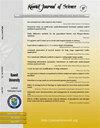Analysis of parameters of the exponentiated inverse Rayleigh distribution under the Bayesian framework
IF 1.1
4区 综合性期刊
Q3 MULTIDISCIPLINARY SCIENCES
引用次数: 0
Abstract
Estimating the unknown parameter(s) of distribution using Bayesian framework is a core topic in statistical literature. This study focuses on the Bayesian estimation and prior selection for the scale and shape parameters of the exponentiated inverse Rayleigh distribution. We consider both informative (chi-square, inverse Lévy) and non-informative (uniform, Jeffreys) priors to update the current state of knowledge regarding the unknown parameters. The squared error loss function (SELF), LINEX loss function (LLF), precautionary loss function (PLF), and quasi-quadratic loss function (QQLF) are employed to demonstrate the effectiveness of priors while estimating the parameters. Expressions for posterior distributions, Bayes estimators (BE), Bayes posterior risks (BPR), credible intervals, and predictive intervals are derived under the aforementioned conditions. Extensive simulation as well as real data analysis is carried out to show the relative performances of the priors and loss functions by comparing the respective BPRs. The results reveal that the inverse Lévy prior outperforms the other priors in terms of minimum BPR and providing tighter credible and predictive intervals while estimating the scale parameter. Whereas, for the shape parameter, the gamma prior shows superior performance. The real data analysis cements the findings of the simulation study.
贝叶斯框架下指数逆瑞利分布参数分析
利用贝叶斯框架估计分布的未知参数是统计文献中的一个核心课题。研究了指数逆瑞利分布尺度参数和形状参数的贝叶斯估计和先验选择。我们同时考虑信息性(卡方,逆lsamvy)和非信息性(均匀,Jeffreys)先验来更新关于未知参数的知识的当前状态。采用误差平方损失函数(SELF)、LINEX损失函数(LLF)、预警损失函数(PLF)和拟二次损失函数(QQLF)验证了先验估计参数的有效性。在上述条件下推导了后验分布、贝叶斯估计量(BE)、贝叶斯后验风险(BPR)、可信区间和预测区间的表达式。通过大量的仿真和实际数据分析,通过比较各自的bpr来显示先验函数和损失函数的相对性能。结果表明,在估计尺度参数时,lsamy逆先验在最小BPR和提供更紧密的可信区间和预测区间方面优于其他先验。而对于形状参数,伽玛先验算法表现出更好的性能。实际数据分析巩固了模拟研究的结果。
本文章由计算机程序翻译,如有差异,请以英文原文为准。
求助全文
约1分钟内获得全文
求助全文
来源期刊

Kuwait Journal of Science
MULTIDISCIPLINARY SCIENCES-
CiteScore
1.60
自引率
28.60%
发文量
132
期刊介绍:
Kuwait Journal of Science (KJS) is indexed and abstracted by major publishing houses such as Chemical Abstract, Science Citation Index, Current contents, Mathematics Abstract, Micribiological Abstracts etc. KJS publishes peer-review articles in various fields of Science including Mathematics, Computer Science, Physics, Statistics, Biology, Chemistry and Earth & Environmental Sciences. In addition, it also aims to bring the results of scientific research carried out under a variety of intellectual traditions and organizations to the attention of specialized scholarly readership. As such, the publisher expects the submission of original manuscripts which contain analysis and solutions about important theoretical, empirical and normative issues.
 求助内容:
求助内容: 应助结果提醒方式:
应助结果提醒方式:


